Biography
Interests
Saeed, T., Tahir, S.*, Tomy, K. N., Mahmood, N., Fernando, A. & Mahalingam, A.
Department of Psychology, Kerry Intervention and Disability Services, Ireland
*Correspondence to: Dr. Tahir, S., Department of Psychology, Kerry Intervention and Disability Services, Ireland.
Copyright © 2020 Dr. Tahir, S., et al. This is an open access article distributed under the Creative Commons Attribution License, which permits unrestricted use, distribution, and reproduction in any medium, provided the original work is properly cited.
Abstract
To understand the psychological impact of Covid-19 on people and to provide support to individuals
going through the effect of this pandemic.
A questionnaire with a 5-point Likert scale was developed by a team of psychologists at Kidsheart
Medical Center, Abu Dhabi, UAE, to assess and evaluate mainly anxiety due to this pandemic.
There were some other auxiliary factors such as the role of religion and perception of the reality of
the pandemic, and utilization of time during the quarantine period that were studied. Studying the
perception of impact of media was also one of the aims of the research during the pandemic. The
questionnaire was circulated using social media platforms and a total of 222 individuals responded
from across the world. The Statistical Package for Social Sciences (SPSS) was used to run factor
analysis and multivariate analysis of variance (MANOVA).
The data revealed that females are experiencing more anxiety than males, and also reported to be
spending their time more effectively during the pandemic. Individuals within the age range of
20-29 were found to be experiencing anxiety more than those in younger and older age groups.
Additionally, individuals who are married reported less anxiety as compared to those who are not
married. Religion however, did not appear to be a factor in neutralizing the stress. Media was
considered to be one of the main factors in creating more stress by spreading unreliable news
among almost all participants.
COVID-19 is a real threat that brought a plethora of difficulties to humankind worldwide. The
uncertain situation has given rise to anxiety in many. Knowing the psychological impacts of COVID-19, we can support each other to reduce anxiety and to improve a sense of well-being.
Introduction
A pandemic is an epidemic occurring worldwide when simultaneous transmission of the influenza takes
place globally [1]. Human history has witnessed a number of pandemics such as smallpox and tuberculosis,
including the most deadly one, known as the Black Death, which killed an estimated 150 million people
over a period of 50 years [2]. The Spanish Flu resulted in 50 million deaths in Europe and America and
parts of Asia in 1918 [3].
The outbreak of COVID-19 has again played havoc with the lives of humans. With nearly 25 million cases now recorded worldwide [4], it has brought the entire world to a complete standstill and halt. The pandemic has affected every possible sector of human lives, including education, employment, health systems, and global economies. Severe restrictions are in place on people’s movements. The concept of working from office has completely changed as workers are encouraged to stay and work from home. Physical confinement has contributed to mental lockdown as well. Increasing number of individuals are suffering from emotional problems which they were not experiencing earlier, such as irritability, fear, confusion, anger, frustration, and insomnia. These emotional problems have been found to be present even after the lifting of quarantine restrictions in several places [5]. In fact, some researchers have found that the mental health problems caused due to COVID-19 were not related to quarantine at all [6]. Similar results were previously seen among a group of college students, where being quarantined did not have a significant correlation with the negative psychological consequences caused by the H1N1 epidemic [7]. One longitudinal study carried out by Wang and colleagues (2020) [8] found that the levels of stress, anxiety, and depression remained stable among the population despite sharp increases in the number of confirmed COVID-19 cases. This study also presented some contradictory evidence to the previously reported studies, as prolonged lockdown was found to have adverse effects on mental health, especially among youth aged 12-21 years. The authors also reported to find PTSD symptoms among the general public.
There is an increase in reported home violence [9,10]; perhaps, because of difficulty to mentally accept these restrictions. We are living in a constant state of existential fear. There is a perpetual battle going on between one’s right of free movement on one hand and existence on the other hand. No one is safe from this pandemic and people from all colours, caste and social status are equally affected. However, people from the lower class strata may get affected more due to lack of facilities and awareness.
During this pandemic, the worry is not only for oneself but for all those around the individual, especially the elderly, as the burden of the pandemic has been much higher on this population (WHO, 2020) [4]. The stress levels further increase when there is a child with special needs in the family. This pandemic is very unusual and it has created a serious dent both physically and psychologically. The intention of the present study was to explore the psychological impact on individuals across the world. This is especially relevant as there have been individuals who were in a state of denial and did not believe in the Covid-19, attributing the pandeming to various factors, such as conspiracy or propaganda by bigger powers. People were protesting protective measures even in a very developed country like the USA, for example wearing masks and closing of markets etc. Also the role of the media which has been so powerful in this modern world was questioned as some of the media houses started to spread news without scientific evidence, creating frenzy amongst masses. There are many research studies which support that religion and spirituality play a significant role as a coping strategy under stress. Perera, Pandey and Kumar, (2018) [11] studied different religious and spiritual coping strategies utilized and they concluded that it is important to treat religion and spirituality as two separate entities. And the most important factor especially with quarantine, when people and children were stuck at home, was to look at the coping strategies individuals were using. Due to these reasons, role of media, religiosity and coping strategies were also explored in the current study.
Methodology
An exploratory study was carried out to assess the psychological impact of COVID-19 on people across
different countries and nationalities. For this purpose a 28-items questionnaire with a 5-point likert scale
was developed by a team of psychologists at Kidsheart Medical Center, Abu Dhabi, UAE, to assess the
following five main factors:
- Anxiety due to Covid-19,
- Perception of the reality of the pandemic,
- Use of time during the pandemic,
- The role of religion.
- Impact of media during the pandemic.
The questionnaire consisted of socio-demographic variables including nationality, gender, age, marital status, and employment status. A pilot study was conducted among the staff of the Kidsheart Medical Center to analyze the feasibility and real properties of the questionnaire.
The questionnaire was subsequently conducted through a convenient sampling method using social media platforms to collect data. It was an anonymous survey and the participants were informed of strict confidentiality in advance. They were informed that the data will not be used for any other purpose except for the intended research. The survey was distributed a number of times and it was retained on the social media platforms for almost a month to get maximum responses. 222 participants completed the questionnaire including people from different countries such as India, Pakistan, Sri Lanka, Egypt, Jordan, UAE, Syria, Australia, Ireland, Philippines, and others. 23.9 percent of the participants did not reveal their nationality. Among the 222 respondents, 66 were males (29.7%) and 156 were females (70.3%).
The Statistical Package for Social Sciences (SPSS) was used to run factor analysis and analysis of variance (ANOVA).
Result
The purpose of this study was to explore the psychological impact of COVID-19 on the general population.
In order to examine the results, all 222 responses were used.
Out of the 222 participants who responded, a total of 120 participants (54%) were employed, 37 (16.7%)
were unemployed, and 65(29.3%) identified themselves as students. Participants ranged within various age
groups, as shown in Figure 1.
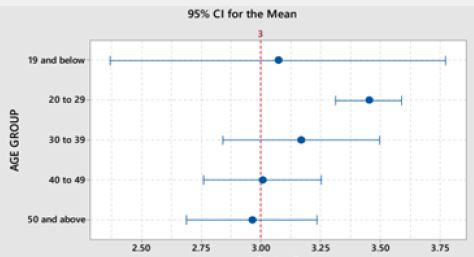
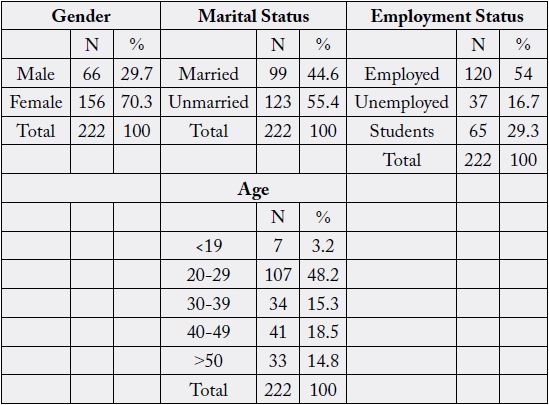
Factor analysis run on the test items identified the following primary factor:
● Anxiety, worry, and uncertainty experienced by individuals.
The data collected suggests that females are highly impacted psychologically and they expressed higher levels of anxiety due to COVID-19 compared to men (Figure 2). Females also reported to use their time more effectively and coped better with the pandemic than men (Figure 3). There was no significant difference seen between the two groups with regards to personal attitudes and beliefs, although males reported slightly more positive attitudes. Both genders agreed that the media plays an important role during the pandemic and can create fear among the population (Figure 4).
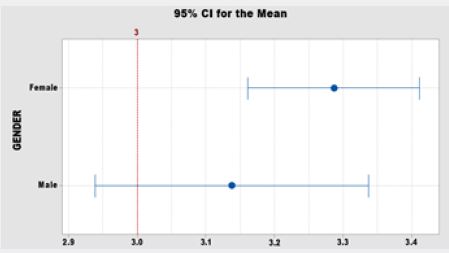
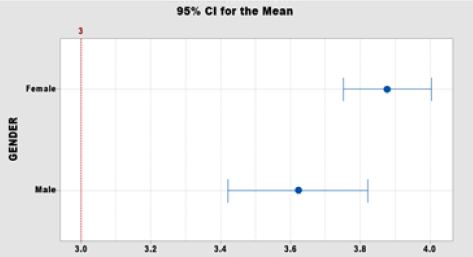
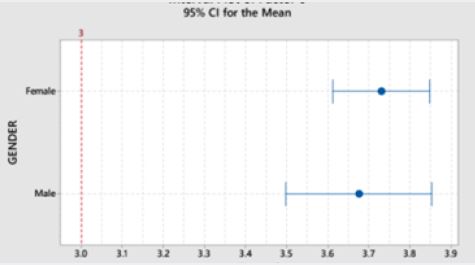
Individuals within the age group 19 and below were found to be less worried and uncertain about the COVID-19 and lockdown as compared to individuals of other ages (Figure 1). In contrast, individuals within the age group of 20-29 were found to be highly anxious when compared to other age groups (Figure 1). Individuals of all age groups agreed that the media has a high impact and plays a role in creating fear and uncertainties among the public (Figure 5). Except for a small proportion of individuals within the 19 and below age group, all participants reported to use their time effectively and cope well, and had positive attitudes and good faith.
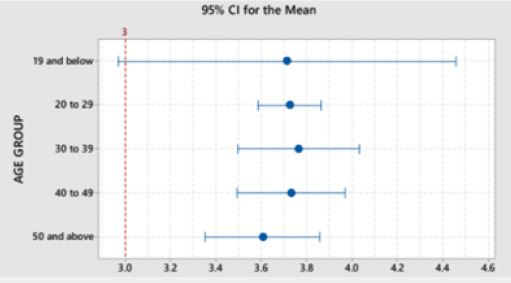
Married participants are less impacted by lockdown and reported to feel less anxious compared to individuals who are unmarried (Figure 6). Both groups reported to use their time effectively and cope well with COVID-19. Participants who are married showed better religious faith compared to unmarried participants (Figure 7). Both groups agree that the media plays a role in creating uncertainty and fear among the public during the pandemic (Figure 8).
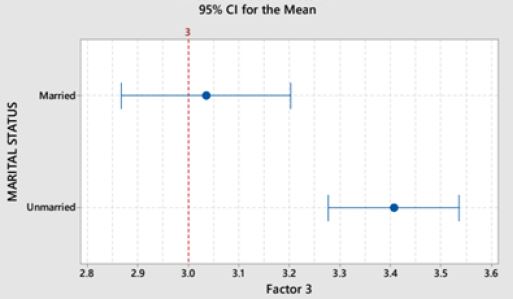
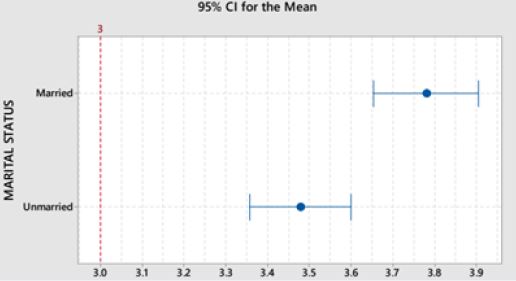
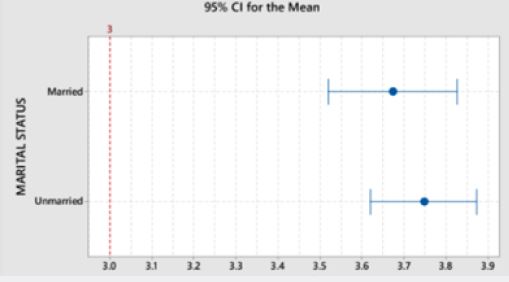
Although some groups were found to be more religious than others, there was no significant correlation between religiosity and anxiety (Figure 9).
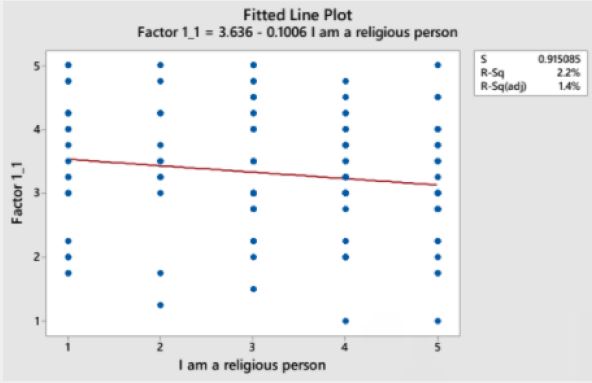
Discussion
The COVID-19 pandemic has dramatically changed the lives of all human beings across the globe. It has
not only impacted the physical and social aspects of peoples’ lives, but also the psychological aspect. One of
the main factors highlighted through the current crisis is anxiety as a psychological impact of COVID-19.
Studies revealed that economic effects, and effects on daily life as well as delays in academic activities
during COVID-19 were positively associated with anxiety symptoms [12]. This factor was substantiated
by the present research that the participants displayed a high level of anxiety. Among the participants
who responded to the present survey, females were found to be experiencing more anxiety as compared to
males. This is in line with already existing evidence on most anxiety-related disorders, that they are more
prevalent in women, affecting twice the number of women than men [13]. Notwithstanding the higher rates
of anxiety feelings seen among females, they reported using their time more effectively and to be coping
better with the pandemic than males. This is again in line with previous literature and knowledge, as women
have been found to be able to manage their time and workload better, especially those who are employed
and are mothers [14]. This pandemic on the other hand provided the opportunity for families to spend more
time with each other and could have been a blessing in disguise. Similar results between the two genders are
also noted among middle-school students, where females scored significantly higher on time management
skills than their male counterparts [15].
Individuals within the age group of 20-29 were found to be most affected by anxiety and uncertainty due to the pandemic as compared with other age groups. Various factors can be taken into account to understand the reasons for these results. Firstly, individuals in this age group are transitioning into adulthood, working towards their higher education, looking for their first jobs, and becoming financially independent. The COVID-19 pandemic has brought uncertainty in all of these areas of transition. According to statistics published by the Organization for Economic Co-operation and Development in 2018 surveying youth in 48 countries, young men and women today already receive lower incomes, and are 2.5 times more likely to be unemployed as compared to the youth of previous generations [16]. The younger generation also has limited financial resources, which significantly affects those living in economically unstable households [17]. In fact, in a recent survey it was found that the three greatest concerns of the youth with regards to the pandemic were mental health, employment, and disposable income [18].
With respect to marital status, our results revealed that married participants are less impacted by lockdown during COVID-19 and reported to feel less anxious compared to individuals who are unmarried. The World Mental Health (WMH) survey reveals that people being in first marriage are having lower risk of mental disorder onset. According to a study conducted in the US, the relationship between marital status and anxiety were mediated by stress related to social commitments, loneliness, and the economy/money (Vivianet et al, 2017). Specifically, individuals who were never married/not dating and never married/ casually dating reported higher levels of social commitments-related stress, which, in turn, increased anxiety. Individuals who were never married/not dating, never married/casually dating, separated, divorced, and widowed reported higher levels of loneliness-related stress, which also increased anxiety. Lastly, individuals who were never married/not dating, never married/ casually dating, separated, and divorced reported higher levels of economic-related stress, which also increased anxiety [19]. From this we can assume that the companionship with their partner and the divided financial responsibilities among the married couple during lockdown might have acted as a protective factor to have lesser anxiety among married couples.
Religion is considered to be the most pacifying factor during stressful times as people revert to their religion as was seen across the globe, especially in religiously conservative countries like India and Pakistan, where people started to say special prayers to protect them from pandemic. A research during COVID 19 demonstrates that the COVID-19 crisis has increased Google searches for prayer to the highest level ever recorded. More than half of the world population had prayed to end the coronavirus [20]. However this research proved otherwise as there was no difference observed between religious and non religious groups. They both were equally affected by the pandemic and religion seems to be not a major factor in reducing the stress level. There are contradictory results observed in previous studies as some research suggested that it is the belief in a specific religion that helps in reducing the stress, while other research suggest that spirituality on its own takes precedence over religious belief. One of the research studies the relations among and between religion, spirituality, and the ability to cope with stress were examined using a sample of 115 graduate students [21]. Both religion and spirituality were positively correlated with coping with stress. However, students who expressed spirituality through religious beliefs had greater spiritual health and immunity to stressful situations than counseling students who identified themselves as spiritual but not religious. Emmons, Cheung & Tehrani (1998) [22] on the other hand found that individuals with spiritual inclination have more inclination to look for meaning in life, marital satisfaction, and general life satisfaction and hence are better equipped with managing stress. However, this pandemic has raised a serious question over the role of religion in coping stress and needs further examination.
Media, in today’s world, is the most dynamic and powerful instrument in directing the attitudes of behaviour. Media gets more resourceful and reliable where people don’t have access to direct information. This however, does not mean that people blindly believe the media and take messages without skepticism [23]. However, they can be instrumental in creating hype about certain information especially in times of crises and before people get access to evidence based information. It was evident in the present research as the majority of the sample agreed that media played a critical role in creating stress.
Conclusion
The COVID-19 pandemic has affected people all over the world. In the current study we could find that
due to this uncertain situation, many people experience anxiety. It is found that compared to men, women
experience more anxiety. At the same time, women are capable of spending time more effectively during the
pandemic. The study revealed married people are less anxious compared to unmarried. Among the various
age groups, people aged 20 to 29 are more anxious. Considering these facts, we need to be empathetic and
compassionate, and extend our helping hands to each other to curb the psychological impact of COVID-19
and to improve resilience. I am sure we will find ways as I have full trust in our scientific community and the
day is not far when we shall succeed.
Bibliography

Hi!
We're here to answer your questions!
Send us a message via Whatsapp, and we'll reply the moment we're available!